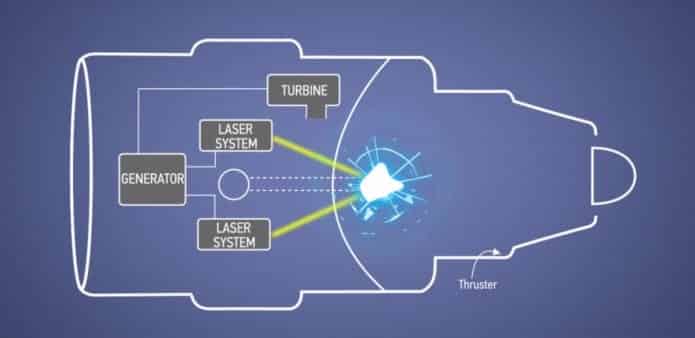Table Of Contents
Patent awarded to Boeing for laser-triggered nuclear fusion powered jet engine, but will Boeing build one?
Boeing’s Robert Budica, James Herzberg, and Frank Chandler applied for a patent for building a laser and nuclear driven airplane engine which got its approval last week from the US Patent and Trademark Office (USPTO).
Airplane makers constantly work on making their products efficient, one example is the presence of multiple turbofan engines in the Boeing Dreamliner, which has a series of fans and turbines that are used to compress the air and ignite the fuel to produce the required thrust.
How would the newly patented engine of Boeing work:
As per the latest patent, Boeing’s new jet engine would fire high power lasers at Deuterium and Tritium, which are radioactive materials.
This results in a small thermonuclear explosion due to which the radioactive material starts to vaporize and ultimately leads to the fusion reaction.
The by-products of this nuclear fusion is Hydrogen or Helium and these get exhausted from the rear end of the engine at a very high pressure. This release of gas under pressure produces the required Thrust and leads in the propulsion of the jet engine.
During the nuclear reaction, high energy neutrons are produced. The inside walls of the engine’s thruster chamber is coated with uranium 238 and this counter reacts with the high energy neutrons to generate enormous heat.
The engine is so designed that a coolant runs along the other side of the uranium-coated combustion chamber and the basic purpose of the coolant is to harness the heat generated during the nuclear combustion.
Further, the heat-energized coolant is made to run through a turbine and generator so as to produce electricity which powers the engine’s lasers.
Thus, the engine requires minimal external energy and it can rely on the radioactive material for its energy requirement.
In technical terms the patent reads:
“The laser system comprising one or more free-electron lasers for providing pulsed laser beams to vaporize pellets comprising the propellant [deuterium and tritium]. As a result of the compression of the deuterium and tritium, the gas mixture reaches sufficiently high temperatures to cause a release of energy… beyond the ‘break-even’ level… increasing the overall thrust and exhaust velocity. …A specific impulse of 100,000 – 250,000 seconds may be provided.”
Thus it can be seen that the newly patented jet engine would be designed to provide a thrust in an altogether novel manner.
As per the patent, Boeing may also use the laser engine to power rockets, spacecrafts and missiles. The Laser and Nuclear fusion powered jet engine however is still on the paper or rather the patent documents.
The fundamental technologies required to make such an engine definitely exist and it can even make such an engine work. Keep your fingers crossed, though, and we just might see the debut of a self-sustaining laser-powered nuclear fusion engine in another 25 years — but for now, it only exists on paper.

